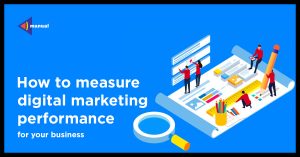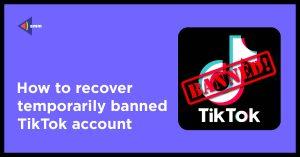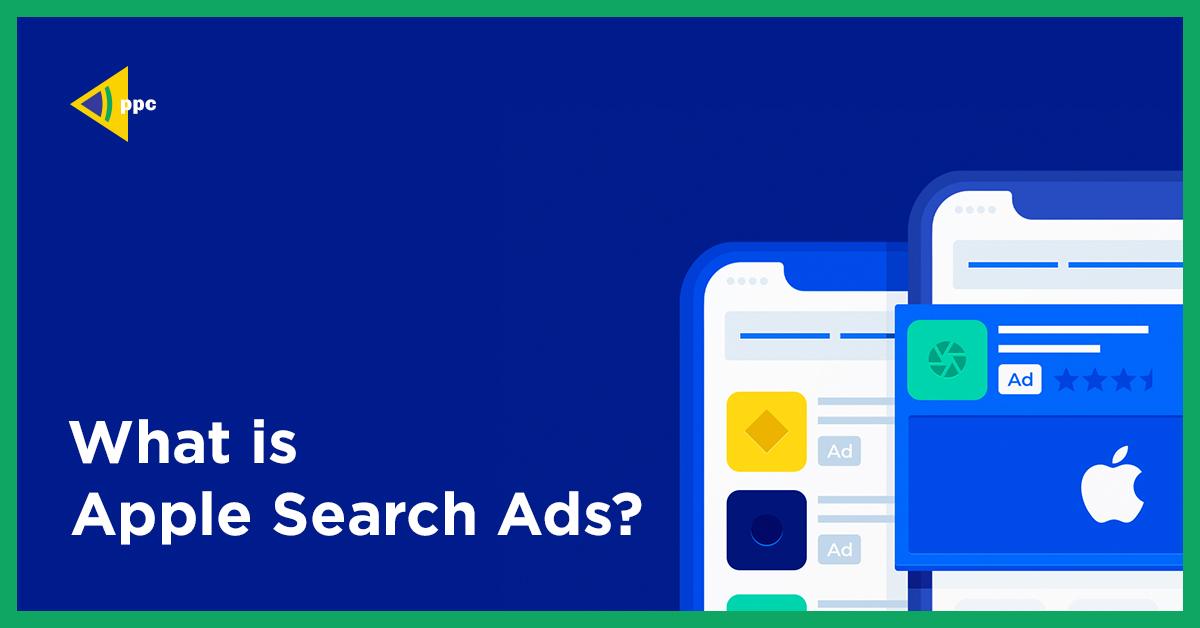
What is Apple Search Ads?
Apple Search Ads (ASA) is one of the most effective ways for advertisers to reach their ideal customers. When a user searches for a specific phrase in the App Store, marketers may ensure that their app is shown to those with a demonstrated interest in that topic.

Why do app developers use Apple Search Ads to promote their apps?
In 2008, when the Apple App Store first opened, there were just 500 applications accessible. Apple has put forth a lot of effort since then to enhance the App Store’s features for both customers and programmers. As things stand, we can confidently conclude that Apple’s team is doing a fantastic job of continually evolving the store and giving developers and app marketers several avenues through which to promote their apps.
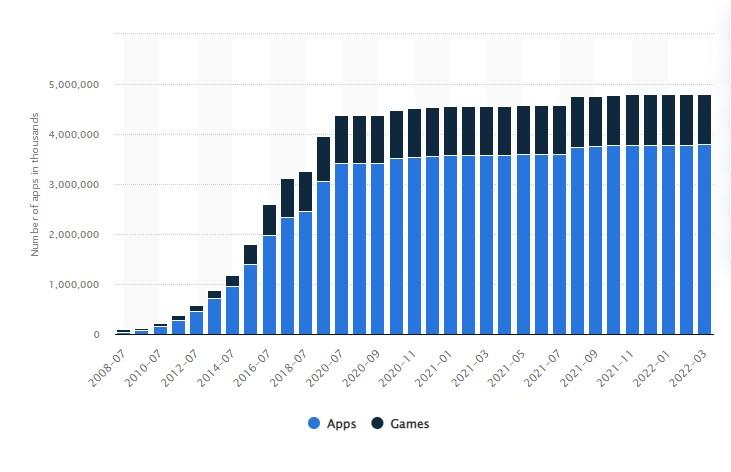
In 2016, Apple launched Search Ads that allow app marketers to promote their apps on Apple App Store. The pay-per-click (PPC) model was in use at the time, making it similar to most other ad networks. But Apple wouldn’t be Apple if it didn’t constantly upgrade and provide new features to its various platforms. Search Ads, with its robust features and analytical insights, is now one of the most potent app marketing strategies available.

More than that, only Apple Search Ads allows advertisers to promote their products inside the App Store itself. In essence, it expedites the process for your app so that it may be used first. In other words, your app advertisement will show up ahead of any organically ranked competitors when users conduct a search related to your app. If you want to increase your user base, your income, and your chances of success, you should employ Apple Search Ads. Seventy percent of users use search to discover new applications.
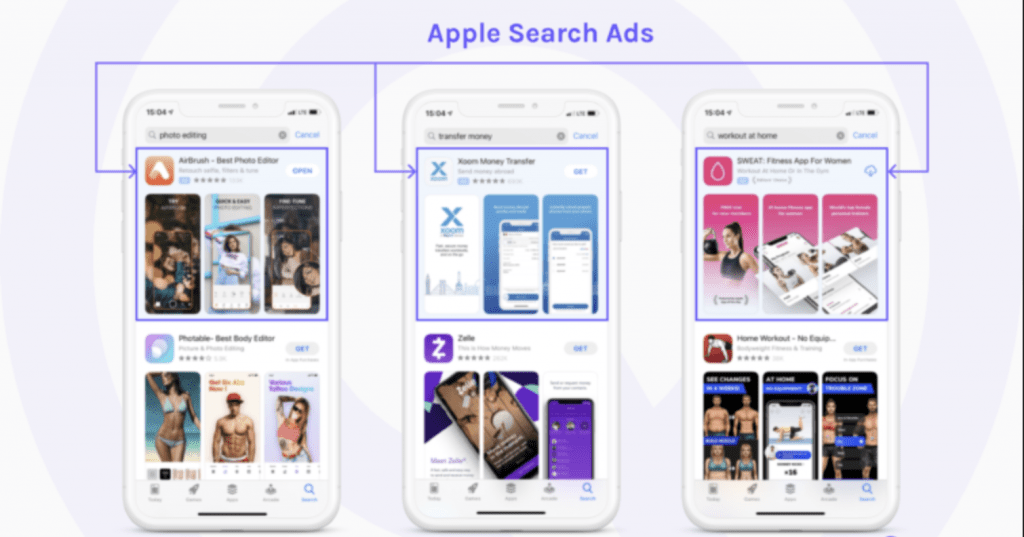
What are Apple Search Ads?
With Apple Search Ads campaigns, advertisers may drastically boost their presence in the App Store. The highest bidder receives the prime real estate in blue at the top of the results page for a given keyword. An advantage over competitors with better app store optimization is having your app featured first on relevant App Store pages (ASO). The effectiveness of this publicity, however, hinges on the method employed: Marketers still need to bid on relevant keywords in ASA if they want their advertisements to convert consumers.
Marketers may choose from two options: Apple Search Ads Basic and Apple Search Ads Advanced. The options for fine-tuning your approach depending on which one you select, with ASA Advanced providing many more possibilities.
Apple Search Ads Basic vs Advanced: What’s the difference?
While all options have their uses, the capabilities of the two tools are very different.
- With ASA Basic, you may market up to 50 applications at a time and spend up to $10,000 per app, every month. Marketers who value budget predictability and straightforward implementation will benefit from this choice. For instance, with ASA Basic, you won’t need to provide target demographics or keywords. Instead, Apple does the work of matching your ad to interested customers. You can see how well your ads are performing as a result of this automation in your analytics dashboard.
ASA Advanced adds to these customizations and provides advertisers more precise targeting possibilities. ASA Advanced gives marketers the freedom to choose their own keywords, schedule when their advertisements appear, and use whatever assets they like. As part of this process, advertisers must determine their KPIs, target audiences, and maximum CPC bids for each ad campaign. - As an upgrade to ASA Basic, ASA Advanced provides you with even more tools to manage your campaigns. You may utilize tools like Search Match or organize your advertising by target audience or keywords. With ASA Advanced, marketers can get comprehensive information on campaign performance, including the most important KPIs. An ASA Advanced user’s monthly budget and the total number of promoted applications are both unrestricted.
With ASA Advanced, you only pay when a user really interacts with your ad by clicking on it. You may specify maximum CPCs to bid competitively without going over budget. Apple will recommend a maximum CPC offer based on the data you provide about your app, increasing your chances of success in each auction.
Can I run both the free and paid versions of Apple’s Search Ads?
While marketing the same software may be done with both systems, any improvements made in ASA Advanced will not transfer to Basic. Apple states in its documentation that “you may merely be shifting impressions from one to the other” if you run Apple Search Ads Advanced and Apple Search Ads Basic simultaneously, since “there is no benefit in the auction for running both at the same time.”
Apple Search Ads: A Quick Start Guide
1. Have a clear idea of where you want to end up
Can you please explain what it is that you want to accomplish?
Do you have new consumers in mind, existing ones, or do you want to reach everyone? All of these factors should be taken into account as you tweak your campaign configurations.
2. Check if your app is ASA-compliant.
- Verify that your app and any extra third-party tracking is set up correctly before beginning your sponsored advertisements.
- Do you collaborate with a third party to monitor user behavior inside the app?
- Does your software provide any further conversion events outside the initial install?
- Does your app provide an explanation page where potential users may sign up to learn more?
3. Settle on the best course of action: Basic or Advanced
To begin, know that app marketers can choose between a Basic and an Advanced plan.
Apple Search Ads Basic:
- If your monthly expenses are less than $10,000
- The price of installations is entirely up to you (CPI)
- All that is left is for Apple’s automation and machine learning to handle.
Apple Searc Ads Advanced:
- If your monthly expenditures are $10,000 or more
- Keyphrases, demographics, and geographic areas may all be zeroed in on.
- Proficient in handling one’s own bids
- With Apple’s Basic offering, you can specify your objectives and have the tech giant take care of the rest. The method is not dissimilar to that of Smart Campaigns, requiring little in the way of time or knowledge to initiate.
Marketers with greater knowledge and means may take advantage of the Advanced package’s increased command and flexibility, which is more akin to that of genuine search PPC campaigns.
Apple Search Ads Campaign Types
Costs are calculated on a CPT (cost per tap) basis for Apple Search Ads Advanced. Make sure that users who click on your ad go on to download your app for the best return on investment. Your marketing framework can help you achieve this goal.
Classifying keywords and match types in accordance with campaign objectives is the most efficient approach for doing so.
Apple Search Ads Brand Campaigns
Promotional Brand Campaigns highlight your app’s brand and name. Simply put, you should be concerned primarily with preserving your brand’s reputation. Please remember that Exact Match keywords are used in Brand Campaigns. The majority of your installs will come from people searching for your precise brand name, therefore optimizing for such phrases is essential. This means that there is a significant possibility that rival businesses are actively attempting to steal your customers by using campaigns centered around keywords associated with your brand. Consumers who are actively looking for your brand and app on the App Store are another target audience for your business’s marketing efforts. These customers have gone to the App Store with a specific goal in mind, rather than just wandering around. As a result, you may get less impressions, but improved click-through and conversion rates (CVR).
Targeted Advertising on Apple’s Search Engine
Apple Search Ads Category Campaigns
Category Campaigns (also called Generic Campaigns) are run using Exact keywords and make use of non-branded keywords to increase the likelihood that your ad will show up when users conduct a search for the function or category to which your app belongs, such as “fitness.” That is, you want to target people who are actively looking for your app or apps like it through your campaign. Ads will still be broadcast to a large audience, thus the number of impressions will be substantial.
Google AdWords and Bing Ads Competitors’ Efforts to Outspend
Equally, Exact Match keywords are used in competitor campaigns. Offensive action is the point of competitor campaigns. To rephrase: you want users who find your app on the App Store while browsing for a competing app to do a U-turn and download your app instead. You may accomplish this by include synonyms and other versions of your rivals’ names in the keywords.
Apple Search Ads Discovery Campaigns
The primary focus of Apple’s Discovery Campaign is to identify high-volume search phrases that are directly related to your app and to introduce such terms to your developers. In other words, Search Match and Broad Match keywords are used to drive these ads. Since you’ll be able to contact more people, you may expect a large number of impressions. To encourage the search engine to discover more relevant search phrases, you should include all targeted keywords as negatives in your query.
Targeting choices are also an integral part of the campaign structure, therefore familiarity with these is essential. There are two distinct tiers of targeting:
ad group by choosing the target audience and the keywords you wish to appear in relevant searches for.
Let’s break down Apple Search Ads Advanced campaigns into their component parts, ad groups and keyword kinds.
Advertisement categories in Apple’s Search Engine
Targeted audiences, or “ad groups,” are the subsets of the population that should see your advertisement. If you use Apple Search Ads Advanced, you can get quite particular about the demographics of your ad groups and target users. However, individuals who do not enable ad tracking are not included in the target audience when using these selections. This might account for as much as 20% of the market’s users. The remaining 80% of Apple users may be narrowly targeted, however, using the following criteria:
- Device (iPhone or iPad)
- Who your typical customer is (Have they used your app before?)
- Demographics (what gender, how old, where, and when should your ad be shown to them)
Apple Search Ads keywords types
As soon as you have established your ad group structure, it is time to begin developing your Apple Search keyword strategy. In order to find apps in the Apple App Store, users enter keywords into the search bar. You may tell Apple specifically which searches you want to see your ad for by using Apple Search Ads Advanced. What follows is a brief illustration of this point.
Let’s pretend you’re in possession of a photo editing program. Make sure terms like “photo editing,” “filters,” and “edit photographs” bring up your app’s ad. You will use them as the keywords in your campaign. Don’t get too caught up in trying to rank for low-volume keywords, but also don’t ignore the importance of keyword difficulty and search volume. If you’re having trouble figuring out which keywords to utilize for your app’s marketing, you can use App Radar’s Keyword Finder to do some preliminary research and spy on what your rivals are doing.
Apple Search Ads Campaigns Structure
Since you already have a basic understanding of how campaigns function and the various sorts of keywords, we can now delve headfirst into the optimal campaign structure and budgeting.
Having 4 campaigns allows you to have more options for advertisements. The optimal campaign layout for your app’s expansion is outlined above. Keep in mind that this is only a suggested framework, and that your actual ad campaign structure may need to be much more basic if you are working with a smaller budget and fewer personnel.
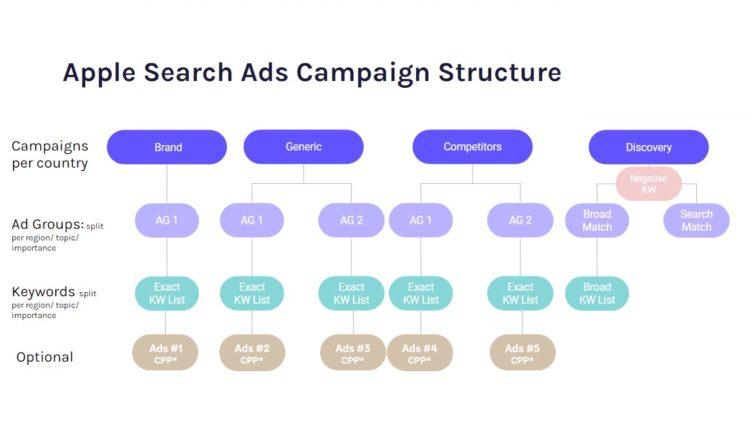
Organizing your Apple Search Ads campaigns in this way will make it simpler to analyze data and make adjustments as needed. On top of that, you won’t have to worry about losing money on ineffective advertisements because you’ll have complete command over all of your active campaigns.
Apple Search Ads uses a cost-per-thousand model, as was previously described. Apple will need to know how much you are willing to pay each click on your app ad. Your bid is the amount you choose to offer.
You may have to up your bid if not enough people are seeing your adverts. In particular, this is true for highly sought-after search terms. On the other hand, if your budget is too high and your conversion rate is too low, you can reduce your expenditure and/or inflation rate. In order to get the most installations for your money, you need have a high conversion rate. The profits you make will increase in this manner.
Summary
Promoting iOS app installs and visibility in search results is a breeze with Apple Search Ads. Since this is the primary method for promoting apps within the Apple App Store, you should expect a significant uptick in both brand recognition and app downloads.
One positive aspect of Apple Search Ads Basic is that it alleviates some of the burden often associated with such an endeavor. You, on the other hand, are in charge with Apple Search Ads Advanced. Which type of Apple Search Ads you employ to expand your app’s user base is entirely up to you, your budget, and your available resources. Remember to evaluate whether or not you have chosen the best choice; otherwise, you may end up waste money and not accomplishing your goals.



